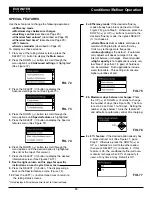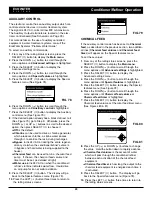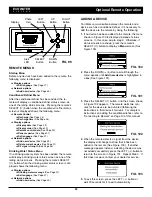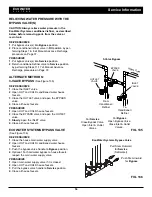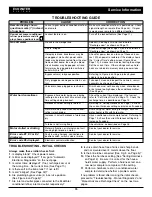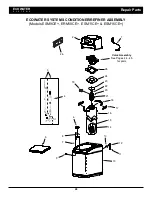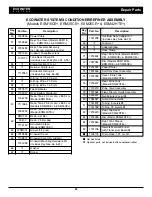
32
REFILLING WITH SALT
If the conditioner/refiner uses all the salt before more is
added, hard water will result. Lift the brine tank lid and
check the salt level frequently. The remote can also be
used to monitor salt. It has an optional display, on the
conditioner/refiner status screen, of the estimated num-
ber of days until salt is depleted (“Out of salt in X
days”). The conditioner/refiner can also be pro-
grammed to display a Low Salt Alarm a certain number
of days before salt is estimated to run out (See Page
12).
Be sure that the brinewell cover is on when adding salt.
After adding and leveling salt, always set the salt level
on the electronic controller, as described on Page 12.
NOTE:
In humid areas it is best to keep the salt level
less than half full and refill more often.
RECOMMENDED SALT:
Cube, pellet, coarse solar,
etc., water conditioner salt is recommended. This type
of salt is high purity evaporated crystals, sometimes
formed and pressed into briquets. It has less than 1%
insoluble (not dissolvable in water) impurities. Clean,
high grade rock salts are acceptable, but may require
frequent brine tank cleaning to remove the “sludge”
residue (insolubles) collecting at the bottom of the tank.
POTASSIUM CHLORIDE:
If you choose potassium
chloride (KCl) salt as a regenerant:
1) Make sure “Salt type” on the electronic control is set
to “KCl”, as shown on Page 12.
2) Place only one bag of potassium chloride (KCl) into
your conditioner/refiner at a time. The salt storage
tank should never contain more than 25 kg of KCl.
SALT NOT RECOMMENDED:
Rock salt high in impuri-
ties, block, granulated, table, ice melting, or ice cream
making salts, etc., are not recommended.
SALT WITH IRON REMOVING ADDITIVE:
Some salts
have an additive to help a water conditioner/refiner han-
dle iron in the water supply. Although this may help
keep the resin bed clean, it may also release corrosive
fumes that will weaken and shorten the life of some
EcoWater Systems conditioner/refiner electronic parts.
Iron Out salt is safe to use on two-tank models.
ECOWATER
S Y S T E M S
Service Information
BREAKING A SALT BRIDGE
Sometimes a hard crust or salt “bridge” forms in the
brine tank. This is usually caused by high humidity or
the wrong kind of salt. When the salt bridges, an empty
space forms between the water and the salt. Then salt
will not dissolve in the water to make brine. Without
brine, the resin bed is not recharged and hard water will
result.
If the storage tank is full of salt, it is difficult to tell
whether there is a salt bridge. A bridge may be under-
neath loose salt. The following is the best way to check
for a salt bridge:
Salt should be loose all the way to the bottom of the
tank. Hold a broom handle, or like tool, up to the condi-
tioner/refiner, as shown in Figure 133. Make a pencil
mark on the handle 3 - 5 cm below the top of the rim.
Then, carefully push it straight down into the salt. If a
hard object is felt before the pencil mark is even with
the top, it is most likely a salt bridge. Carefully push
into the bridge in several places to break it.
Do not try
to break the salt bridge by pounding on the outside
of the salt tank. You may damage the tank.
FIG. 133
3 - 5 cm
Pencil Mark
Broom
Handle
Push tool into
salt bridge
to break
Water Level
Empty Space
Salt Bridge
Salt


